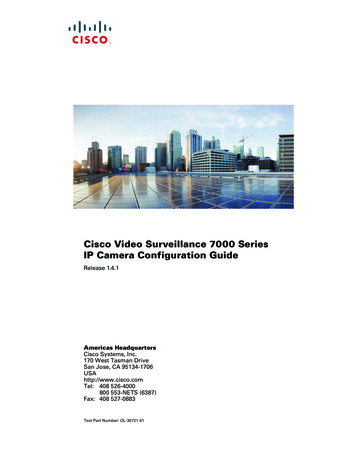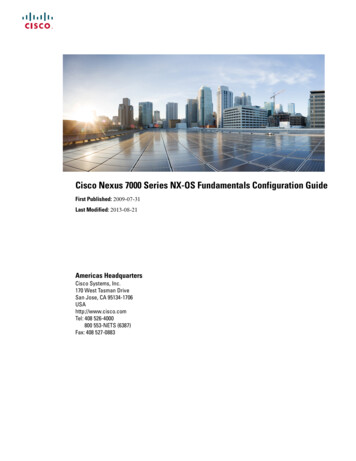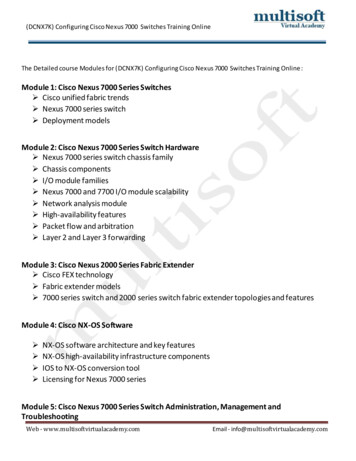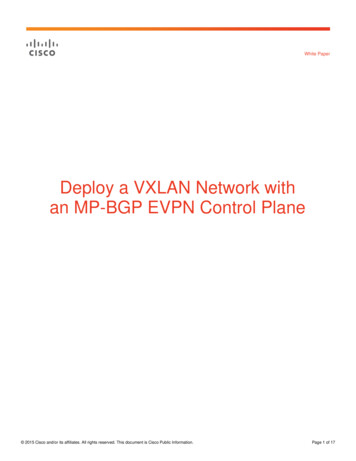
Transcription
Cisco Video Surveillance 7000 SeriesIP Camera Configuration GuideRelease 1.4.1Americas HeadquartersCisco Systems, Inc.170 West Tasman DriveSan Jose, CA 95134-1706USAhttp://www.cisco.comTel: 408 526-4000800 553-NETS (6387)Fax: 408 527-0883Text Part Number: OL-30721-01
NOTICE. ALL STATEMENTS, INFORMATION, AND RECOMMENDATIONS IN THIS MANUAL ARE BELIEVED TO BE ACCURATE BUT ARE PRESENTEDWITHOUT WARRANTY OF ANY KIND, EXPRESS OR IMPLIED. USERS MUST TAKE FULL RESPONSIBILITY FOR THEIR APPLICATION OF ANY PRODUCTS.THE SOFTWARE LICENSE AND LIMITED WARRANTY FOR THE ACCOMPANYING PRODUCT ARE SET FORTH IN THE INFORMATION PACKET THATSHIPPED WITH THE PRODUCT AND ARE INCORPORATED HEREIN BY THIS REFERENCE. IF YOU ARE UNABLE TO LOCATE THE SOFTWARE LICENSEOR LIMITED WARRANTY, CONTACT YOUR CISCO REPRESENTATIVE FOR A COPY.The Cisco implementation of TCP header compression is an adaptation of a program developed by the University of California, Berkeley (UCB) as part of UCB’s publicdomain version of the UNIX operating system. All rights reserved. Copyright 1981, Regents of the University of California.NOTWITHSTANDING ANY OTHER WARRANTY HEREIN, ALL DOCUMENT FILES AND SOFTWARE OF THESE SUPPLIERS ARE PROVIDED “AS IS” WITHALL FAULTS. CISCO AND THE ABOVE-NAMED SUPPLIERS DISCLAIM ALL WARRANTIES, EXPRESSED OR IMPLIED, INCLUDING, WITHOUTLIMITATION, THOSE OF MERCHANTABILITY, FITNESS FOR A PARTICULAR PURPOSE AND NONINFRINGEMENT OR ARISING FROM A COURSE OFDEALING, USAGE, OR TRADE PRACTICE.IN NO EVENT SHALL CISCO OR ITS SUPPLIERS BE LIABLE FOR ANY INDIRECT, SPECIAL, CONSEQUENTIAL, OR INCIDENTAL DAMAGES, INCLUDING,WITHOUT LIMITATION, LOST PROFITS OR LOSS OR DAMAGE TO DATA ARISING OUT OF THE USE OR INABILITY TO USE THIS MANUAL, EVEN IF CISCOOR ITS SUPPLIERS HAVE BEEN ADVISED OF THE POSSIBILITY OF SUCH DAMAGES.Cisco and the Cisco logo are trademarks or registered trademarks of Cisco and/or its affiliates in the U.S. and other countries. To view a list of Cisco trademarks, go to thisURL: www.cisco.com/go/trademarks. Third-party trademarks mentioned are the property of their respective owners. The use of the word partner does not imply a partnershiprelationship between Cisco and any other company. (1110R)Cisco Video Surveillance 7000 Series IP Camera Configuration GuideCopyright 2013 Cisco Systems, Inc. All rights reserved.
CONTENTSPrefacevOverviewvOrganizationvObtaining Documentation and Submitting a Service RequestCHAPTER1Overview1-1IP Camera Features1-1Accessing the IP Camera1-2Understanding the IP Camera User InterfaceIP Camera Window Links 1-4IP Camera Windows 1-5CHAPTER2Performing the Initial Setup of the IP CameraCHAPTER3Viewing Live VideoCHAPTER4Feature Setup2-14-1Camera Window4-14-14Video Overlay WindowIO Ports Window4-164-17Event Notification WindowLocal Storage Window51-43-1Streaming WindowCHAPTERviNetwork Setup4-184-245-1Basic Window5-1IP Addressing WindowTime Window5-35-4Discovery Window5-6Medianet Window5-7SNMP Window5-8802.1x Window5-10Cisco Video Surveillance 7000 Series IP Camera Configuration GuideOL-30721-01iii
ContentsIP Filter WindowQoS ion WindowUser Window6-16-2Maintenance WindowFirmware Window6-46-6Device Processes Window6-7Password Complexity WindowCHAPTER7Log Configuration6-87-1Log Setup Window7-1Local Log Window7-4INDEXCisco Video Surveillance 7000 Series IP Camera Configuration GuideivOL-30721-01
PrefaceOverviewThis document, Cisco Video Surveillance 7000 Series IP Camera Configuration Guide, providesinformation about installing and deploying the Cisco Video Surveillance 7000 Series IP Cameras.OrganizationThis manual is organized as follows:Chapter 1, “Overview”Provides information about the IP camera features, instructionsfor accessing the user interface, and information about the userinterface.Chapter 2, “Performing the InitialSetup of the IP Camera”Provides information and instructions about performing theinitial setup of the IP camera.Chapter 3, “Viewing Live Video”Provides information and instructions about viewing live video.Chapter 4, “Feature Setup”Provides information and instructions for configuring IP camerafeatures, such as streaming, camera capabilities, video overlay,I/O ports, and events.Chapter 5, “Network Setup”Provides information and instructions for configuring networksettings, such as IP addressing, time, discovery, IP filtering, andquality of service (QoS).Chapter 6, “Administration”Provides information and instructions for performingadministrative tasks, such as IP camera initialization, usermanagement, maintenance, firmware upgrade, device processesmanagement, and password complexity.Chapter 7, “Log Configuration”Provides information and instructions for configuring andviewing logs.Cisco Video Surveillance 7000 Series IP Camera Configuration GuideOL-30721-01v
PrefaceObtaining Documentation and Submitting a Service RequestFor information on obtaining documentation, using the Cisco Bug Search Tool (BST), submitting aservice request, and gathering additional information, see What’s New in Cisco Product Documentationat: hatsnew.html.Subscribe to What’s New in Cisco Product Documentation, which lists all new and revised Cisco technicaldocumentation, as an RSS feed and deliver content directly to your desktop using a reader application. TheRSS feeds are a free service.Cisco Video Surveillance 7000 Series IP Camera Configuration GuideviOL-30721-01
CH A P T E R1OverviewThis chapter provides information about the Cisco Video Surveillance 7000 Series IP camera features,instructions for accessing the user interface, and information about the user interface. It includes thefollowing topics: IP Camera Features, page 1-1 Accessing the IP Camera, page 1-2 Understanding the IP Camera User Interface, page 1-4IP Camera FeaturesThe Cisco Video Surveillance 7000 Series IP cameras offer a feature-rich digital camera solution for avideo surveillance system. The cameras provide high-definition (HD) video and simultaneous H.264 andMJPEG compression, streaming up to 30 frames per second (fps) at 1080p (up to 2560 x1920) resolution.In addition, the 7000 Series IP cameras provide networking and security capabilities, including multicastsupport, hardware-based Advanced Encryption Standard (AES), and hardware-based Data EncryptionStandard/Triple Data Encryption Standard (DES/3DES) encryption. The cameras can be poweredthrough an external power supply or by integrated Power over Ethernet (PoE).The 7000 Series IP cameras include the following key features: H.264 and MJPEG compression—The IP camera can generate H.264 and MJPEG streamssimultaneously. Privacy regions—Up to four user-defined masking zones can be used to provide regions of privacyin the camera field of view. Video within privacy regions is not recorded in the camera, nor sent inthe video stream. Progressive scan video—The IP camera captures each frame at its entire resolution usingprogressive scan rather than interlaced video capture, which captures each field of video. Analog video output—Supports analog video for all resolutions with 15 fps or lower with nosecondary stream. Medianet—The IP camera supports the Auto Smartports feature of the Media Services Interface(MSI). MSI enables a camera to participate as an endpoint in the Cisco medianet architecture whenconnected to a medianet enabled switch. Local Storage—Supports up to 8 GB of video data storage on a micro SD memory card when thecamera loses network connectivity.Cisco Video Surveillance 7000 Series IP Camera Configuration GuideOL-30721-011-1
Chapter 1OverviewAccessing the IP Camera Two-way audio communication—Audio can be encoded with the video. With the internal oroptional external microphone and optional external speaker, you can communicate with people atthe IP camera location while you are in a remote location and viewing images from the IP camera. Day/night switch support—An IR-cut filter provides increased sensitivity in low-light conditions. Multi-protocol support—Supports these protocols: DHCP, HTTP, HTTPS, NTP, RTP, RTSP,SMTP, SSL/TLS, and TCP/IP. Web-based management—You perform ongoing administration and management of the IP camerathrough web-based configuration menus. Remote Focus/Zoom Control—Built-in stepping motors allow you to remotely adjust theIP camera focal length and zoom factor. Motion detection—The IP camera can detect motion in user-designated fields of view by analyzingchanges in pixels and generate an alert if motion is detected. Flexible scheduling—You can configure the IP camera to respond to events that occur within adesignated schedule. Syslog support—The IP camera can send log data to a Syslog server. IP address filter—You can designate IP addresses that can access the IP camera and IP addressesthat cannot access the IP camera. User-definable HTTP/ HTTPS port number—Allows you to define the port that is used toconnect to the camera through the Internet. DHCP support—The IP camera can automatically obtain its IP addresses in a network in whichDHCP is enabled. Network Time Protocol (NTP) support—Allows the IP camera to calibrate its internal clock witha local or Internet time server. Support for C and CS mount lenses—The IP camera supports a variety of C and CS mount lenses. Power options—The IP camera can be powered with 24 volts AC, which is provided through anoptional external power adapter, or through PoE (802.3af), which is provided through a supportedswitch. Camera access control—You can control access to IP camera configuration windows and livevideo by configuring various user types and log in credentials. Open Network Video Interface Forum (ONVIF) 2.0—ONVIF is an open industry forum for thedevelopment of a global standard for the interface of IP-based physical security products. Thefollowing features are supported:– Device Discovery Service– Device Service– Media ServiceAccessing the IP CameraAfter you perform the initial configuration as described in Chapter 2, “Performing the Initial Setup ofthe IP Camera,” follow the steps in this section each time that you want to access the IP camera windowsto make configuration settings, view live video, or perform other activities.Cisco Video Surveillance 7000 Series IP Camera Configuration Guide1-2OL-30721-01
Chapter 1OverviewAccessing the IP CameraYou access these windows by connecting to the IP camera from any PC that is on the same network asthe IP camera and that meets these requirements: Operating system—Microsoft Windows 7 (32-bit or 64-bit) Browser—Internet Explorer 8.0 (32-bit only)You need this information to access the IP camera windows: IP address of the IP camera. By default, the IP camera attempts to obtain an IP address from a DHCPserver in your network. If the IP camera cannot obtain an IP address through DHCP within 90seconds of powering up or resetting, it uses the default IP address of 192.168.0.100. Port number, if other than the default value. Default port numbers for the IP camera are 443 forHTTPS and 80 for HTTP. The IP camera administrator can configure an HTTPS port and an HTTPport as described in the “Initialization Window” section on page 6-1. Your user name and password for the IP camera. The IP camera administrator configures user namesand passwords as described in the “User Window” section on page 6-2.To access the IP camera windows, perform these steps.Before you BeginMicrosoft .NET Framework version 2.0 or later must be installed on the PC that you use to connect tothe IP camera. You can download the .NET Framework from the Microsoft website.ProcedureStep 1Start Internet Explorer, and enter the following in the address field:protocol://ip address:port numberwhere: protocol is HTTPS for a secure connection or HTTP for a non-secure connection. You can useHTTP only if you configure the camera to accept non-secure HTTP connections as described inChapter 2, “Performing the Initial Setup of the IP Camera.” ip address is the IP address of the IP camera. The default IP address is 192.168.0.100. port number is the port number that is used for HTTPS or HTTP connections to the IP camera. Youdo not need to enter a port number if you are connecting through the default HTTPS port 443 or thedefault HTTP port 80.For example, Enter the following for a secure connection if the IP address is 192.168.0.100 and the HTTPS portnumber is 443:https://192.168.0.100 Enter the following for a secure connection if the IP address is 203.70.212.52 and the HTTPS portnumber is 1024:https://203.70.212.52:1024 Enter the following for a non-secure connection if the IP address is 203.70.212.52 and the HTTPport number is 80:http://203.70.212.52 Enter the following for a non-secure connection if the IP address is 203.70.212.52 and the HTTPport number is 1024:Cisco Video Surveillance 7000 Series IP Camera Configuration GuideOL-30721-011-3
Chapter 1OverviewUnderstanding the IP Camera User Interfacehttp://203.70.212.52:1024Step 2Enter your IP camera user name and password in the Username and Password fields, then click Login.To log in as the IP camera administrator, enter the user name admin (which is case sensitive) and thepassword that is configured for the administrator. To log in as a user, enter the user name and passwordthat are configured for the user.The Home window for the IP Camera appears.Understanding the IP Camera User InterfaceAfter you log in to the IP camera, you can access the IP camera windows and perform a variety ofadministrative and user procedures.The links and activities that you can see and access in the IP camera windows depend on your IP cameraprivilege level. Privilege levels are configured as described in the “User Window” section on page 6-2and include the following: Administrator—Can access all IP camera windows, features, and functions. Viewer—Can access the Camera Video & Control window with limited controls, and can access theRefresh, Logout, About, and Help links from that window.IP Camera Window LinksThe IP Camera user interface includes links that you use to access various windows and perform otheractivities. Table 1-1 describes each link and lists the IP camera privilege level that you must have toaccess the link.Table 1-1Links in the IP Camera WindowsLinkDescriptionPrivilege LevelRefreshUpdates the information in the window that is currently displayed. AdministratorUserHomeDisplays the System Information window. For more information,see Table 1-2.AdministratorView VideoDisplays the Camera Video & Control window.AdministratorYou may be prompted to install ActiveX controls when trying toUseraccess this window for the first time. ActiveX controls are requiredto view video from the IP camera. Follow the on-screen prompts toinstall ActiveX controls.SetupDisplays the Setup window and provides access to the configuration Administratormenus for the IP camera.LogoutLogs you out from the IP camera.AdministratorUserCisco Video Surveillance 7000 Series IP Camera Configuration Guide1-4OL-30721-01
Chapter 1OverviewUnderstanding the IP Camera User InterfaceTable 1-1Links in the IP Camera Windows (continued)LinkDescriptionPrivilege LevelAboutDisplays a pop-up window with model, version, and copyrightinformation for the IP camera.AdministratorDisplays reference information for the window that is currentlydisplayed.AdministratorHelpUserUserIP Camera WindowsThe IP camera user interface includes these main windows: System Information window—Accessed by clicking the Home link. Displays the information that isdescribed in Table 1-2. Camera Video & Control window—Accessed by clicking the View Video link. Displays live videofrom the camera and lets you control a variety of camera and display functions. For detailedinformation, see Chapter 3, “Viewing Live Video.” Setup window—Accessed by clicking the Setup link. Provides access to the IP camera configurationwindows. For detailed information, see the following chapters:– Chapter 4, “Feature Setup.”– Chapter 5, “Network Setup.”– Chapter 6, “Administration.”– Chapter 7, “Log Configuration.”Table 1-2System Information WindowFieldDescriptionGeneral InformationIDIdentifier of the IP camera. To configure the ID, see the “Basic Window”section on page 5-1.NameName of the IP camera. To configure the name, see the “Basic Window”section on page 5-1.Current TimeCurrent date and time of the IP camera. To set the date and time, see the“Time Window” section on page 5-4.S/NSerial number of the IP camera.FirmwareVersion of the firmware that is installed on the IP camera.Part NumberCisco manufacturing part number of the IP camera.Top Assembly Revision Cisco assembly revision number.Network StatusMAC AddressMAC address of the IP camera.Configuration TypeMethod by which the IP camera obtains its IP address. To configure thismethod, see the “IP Addressing Window” section on page 5-3.LAN IPIP address of the LAN to which the IP camera is connected. To configure thisIP address, see the “IP Addressing Window” section on page 5-3.Cisco Video Surveillance 7000 Series IP Camera Configuration GuideOL-30721-011-5
Chapter 1OverviewUnderstanding the IP Camera User InterfaceTable 1-2System Information Window (continued)FieldDescriptionSubnet MaskSubnet mask of the LAN to which the IP camera is connected. To configurethe subnet mask, see the “IP Addressing Window” section on page 5-3.Gateway AddressIP address of the gateway through which the IP camera is connected. Toconfigure this IP address, see the “IP Addressing Window” section onpage 5-3.Primary DNSIP address of the primary DNS server, if configured for the IP camera. Toconfigure a primary DNS server, see the “IP Addressing Window” sectionon page 5-3.Secondary DNSIP address of the secondary DNS server, if configured for the IP camera. Toconfigure a secondary DNS server, see the “IP Addressing Window” sectionon page 5-3.IO Port StatusInput PortCurrent state of the three input ports on the IP camera. To configure an inputport, see the “IO Ports Window” section on page 4-17.Output PortCurrent state of the output port on the IP camera. To configure an output port,see the “IO Ports Window” section on page 4-17.Stream 1 and Stream 2UserIP camera user name of each user who is accessing the primary video stream(Stream 1) or the secondary video stream (Stream 2) through a client PC ora third-party device.By default, users appear in order of start time. To display users in ascendingorder of any information in any corresponding column, click the columnheading. Click a column heading again to reverse the display order.IP AddressIP address of the client device.Start TimeTime and date that the client accessed the video stream for this session.Elapsed TimeLength of time that the client has been accessing the video stream.CodecVideo codec (H.264 or MJPEG) being used for the stream.Cisco Video Surveillance 7000 Series IP Camera Configuration Guide1-6OL-30721-01
CH A P T E R2Performing the Initial Setup of the IP CameraAfter you install the IP camera, or after you perform a factory reset procedure, you must access the IPcamera and make initial configuration settings. These settings include administrator and root passwords,and whether the IP camera can be accessed through an HTTP connection in addition to the defaultHTTPS (HTTP secure) connection.To make these configuration settings, you connect to the IP camera from any PC that is on the samenetwork as the IP camera. The PC must meet these requirements: Operating system—Microsoft Windows 7 Enterprise (32-bit or 64-bit) Browser—Internet Explorer 8.0 (32-bit only)In addition, you must know the IP address and default login credentials of the IP camera. By default,when the IP camera powers on, it attempts to obtain an IP address from a DHCP server in your network.If the camera cannot obtain an IP address through DCHP within 90 seconds, it uses a default IP addressof 192.168.0.100. The default login credentials (Username/Password) are admin/admin.To connect to the IP camera for the first time and make initial configuration settings, perform thefollowing steps. You can change these configuration settings in the future as described in the CiscoVideo Surveillance 7000 Series IP Camera Configuration Guide.Before you BeginThe Microsoft .NET Framework version 2.0 or later must be installed on the PC that you use to connectto the IP camera. You can download the .NET Framework from the Microsoft website.ProcedureStep 1Start Internet Explorer, enter HTTPS://ip address in the address field, and press Enter.Replace ip address with the IP address that the IP camera obtained through DHCP or, if the camera wasunable to obtain this IP address, enter 192.168.0.100.The Login window appears.Step 2Enter the default login credentials:Username: adminPassword: adminThe Initialization window appears.Cisco Video Surveillance 7000 Series IP Camera Configuration GuideOL-30721-012-1
Chapter 2Step 3Performing the Initial Setup of the IP CameraIn the Password and Confirm Password fields of the admin row, enter a password for the IP cameraadministrator.You must enter the same password in both fields. The password is case sensitive and must contain atleast eight characters, which can be letters, numbers, and special characters, but no spaces. Specialcharacters are: ! " # % & ' ( ) * , - . : ; ? @ [ \ ] { } .Step 4In the Password and Confirm Password fields of the Root row, enter a password that is used whenaccessing the IP camera through a Secure Shell (SSH) connection.You must enter the same password in both fields. The password is case sensitive and must contain atleast eight characters, which can be letters, numbers, and special characters, but no spaces. Specialcharacters are: ! " # % & ' ( ) * , - . : ; ? @ [ \ ] { } .You use the root password if you need to troubleshoot the IP camera through a SSH connection with theassistance of the Cisco Technical Assistance Center.Step 5In the Access Protocols area, check the Enable HTTP check box if you want to allow both HTTP andHTTPS connections to the IP camera.By default, only the Enable HTTPS check box is checked, which allows only HTTPS (secure)connections to the IP camera.Step 6Click Apply.The IP camera reboots and the Login window appears.Step 7After the IP camera reboots, start Internet Explorer and, in the Address field, enter the following:protocol://ip addresswhere:Step 8 protocol is HTTPS or HTTP. (You can use HTTP only if you enabled it in Step 5.) ip address is the IP address that you used in Step 1.If you are prompted to install ActiveX controls, which are required to view video from the IP camera,follow the on-screen prompts to do so.The Home window appears.Cisco Video Surveillance 7000 Series IP Camera Configuration Guide2-2OL-30721-01
CH A P T E R3Viewing Live VideoAfter you install and set up the Cisco Video Surveillance IP Camera, you can connect to the IP camerathrough Internet Explorer and access the Camera Video & Control window to view live video from theIP camera.The Camera Video & Control window also provides for controlling the video display, configuring presetpositions, and controlling certain IP camera functions. Available controls depend on the privilege levelof the user.To view live video, log in to the IP camera and click View Video in the IP camera Main window menubar. The Camera Video & Control window appears. This window displays live video from the cameraand lets you control a variety of camera and display functions.The controls that you see in the Camera Video & Control window depend on your IP camera privilegelevel and the configurations settings for the IP camera. Users with the Administrator privilege can accessall controls. Users with the Viewer privilege do not have access to the following controls: Video Control Camera Settings Motion Detection Privacy ZoneTable 3-1 describes the controls in the Camera Video & Control window.Table 3-1ControlCamera Video & Control Window ControlsDescriptionVideo ControlVideo Codecdrop-down listChoose the codec for video transmission (H.264 or MJPEG).You can choose MJPEG or H.264 if the primary video stream (channel 1) isenabled.You can choose MJPEG or H.264 if the secondary video stream (channel 2)is enabled.For information about enabling and disabling video streams, see the“Streaming Window” section of Feature Setup.Cisco Video Surveillance 7000 Series IP Camera Configuration GuideOL-30721-013-1
Chapter 3Table 3-1Viewing Live VideoCamera Video & Control Window Controls (continued)ControlDescriptionVideo Resolutiondrop-down listChoose the resolution for video transmission. The resolutions in thisdrop-down list depend on the video standard that you selected.The default value for H.264 is 2560 x 1920. The default value for MJPEG is704 x 480.NoteYou can also change the resolution for video transmission bychanging the value in the Video Resolution Type field, as describedin the “Streaming Window” section of Feature Setup.Image ToolsHotspot zoom buttonClick this latch button to enable the digital zoom feature, which providesfive-step digital zooming in for the normal (not full screen) video display.Click this button again to disable the digital zoom feature.To perform a digital zoom, engage the Hotspot zoom button and click thevideo display. The first five clicks zoom the display. The sixth click returnsto unzoomed display.Hotspot pan tiltbuttonClick this latch button to enable the hotspot pan/tilt feature, which lets youpan and tilt the IP camera toward a point that you click in the video display.To perform a hotspot pan/tilt action, engage the Hotspot pan tilt button,then click the video image at the location toward which you want the IPcamera to pan and tilt.This feature requires that the IP camera be installed with a pan/tilt mount thatsupports the Pelco D protocol and that pan and tilt functions are enabled.Save snapshot button Capture and save the current video image as a .gif file or a .jpg file in thelocation of your choice and with the file name of your choice.When you click this button, the Snapshot window appears. Click Save andfollow the on-screen prompts to save the image with the name and in thelocation that you want.Flip buttonRotate the video image by 180 degrees.Mirror buttonReverse the video image.Restore buttonDisplay the default video image, which is not rotated and not reversed.Full Screen buttonDisplay the video image in full screen mode.To return to normal display mode, click the full screen image.Cisco Video Surveillance 7000 Series IP Camera Configuration Guide3-2OL-30721-01
Chapter 3Viewing Live VideoTable 3-1Camera Video & Control Window Controls (continued)ControlDescriptionAudio ControlDisable Speakertoggle buttonClick the Disable Speaker button to mute audio that is sent from the IPcamera to the PC that you are using. The button changes to the EnableSpeaker button. Click the Enable Speaker button to unmute audio. Thebutton changes to the Disable button.Enable Speakertoggle buttonMute Microphonetoggle buttonClick the Mute Microphone button to mute the audio stream that is capturedand sent to the IP camera from the internal or external microphone of the PCthat you are using. When you click this button, the speaker that is attached tothe IP camera does not play audio that is transmitted from your PC.NoteUnmute Microphonetoggle buttonIf you are simultaneously accessing other IP cameras in differentbrowser sessions on the same PC, clicking this button in one browsersession does not mute the audio that the PC sends to the other IPcameras.When you click the Mute Microphone button, it changes to the UnmuteMicrophone button. Click the Unmute Microphone button to unmute audiothat is sent to the IP camera. The button changes to the Mute Microphonebutton.Restore buttonReset audio controls to their default values.Speaker Volume slider When the speaker is unmuted, drag this slider to adjust the volume at whichand fieldyour PC speakers play the audio from the IP camera, or enter a value from 0through 100 and press the Enter key.The default value is 50.MicrophoneSensitivity slider andfieldDrag this slider to adjust the gain of the PC microphone (that is, how sensitiveit is to the audio that it picks up and that is sent to the IP camera), or enter avalue from 0 through 100 and press the Enter key.The default value is 50.Camera SettingsCisco Video Surveillance 7000 Series IP Camera Configuration GuideOL-30721-013-3
Chapter 3Table 3-1Viewing Live VideoCamera Video & Control Window Controls (continued)ControlDescriptionUp Arrow togglebuttonClick the Up Arrow to display the camera settings. The button changes to theDown Arrow buttonDown Arrow togglebuttonClick the Down Arrow button to hide the camera settings. The button changesto the Up Arrow button.When the Up Arrow is clicked to display the camera settings, three drawersappear to the right of the video image. The camera settings are grouped intothe three drawers as follows: Picture Adjustments Exposure Control Advanced SettingsTo view the settings within a drawer, click on it to expand it. To hide thesettings, click on the drawer to collapse it.Save buttonSave the current camera setting configurations.Picture AdjustmentsNoteThese controls appear when you click Camera Settings Up Arrow Picture Adjustments.Brightness sliderTo control the brightness of the video image, drag the slider, or enter a valuefrom 1 through 10 and press the Enter key. A higher value increases thebrightness, and a lower value decreases the brightness. For example, if the IPcamera is facing a bright light and the video appears too dark, you canincrease the brightness.The default value is 5.Contrast sliderTo control contrast of the video image, drag the slider, or enter a value from1 through 10 and press the Enter key. A higher value increases the contrast,and a lower value decreases the contrast.The default value is 5.Sharpness sliderTo control the sharpness of the video from the IP camera, drag th
The Cisco Video Surveillance 7000 Series IP cameras offer a feature-rich digital camera solution for a video surveillance system. The cameras provide high-definition (HD) video and simultaneous H.264 and MJPEG compression, streaming up to 30 frames per second (fps) at 1080p (up to 2560 x1920) resolution.










